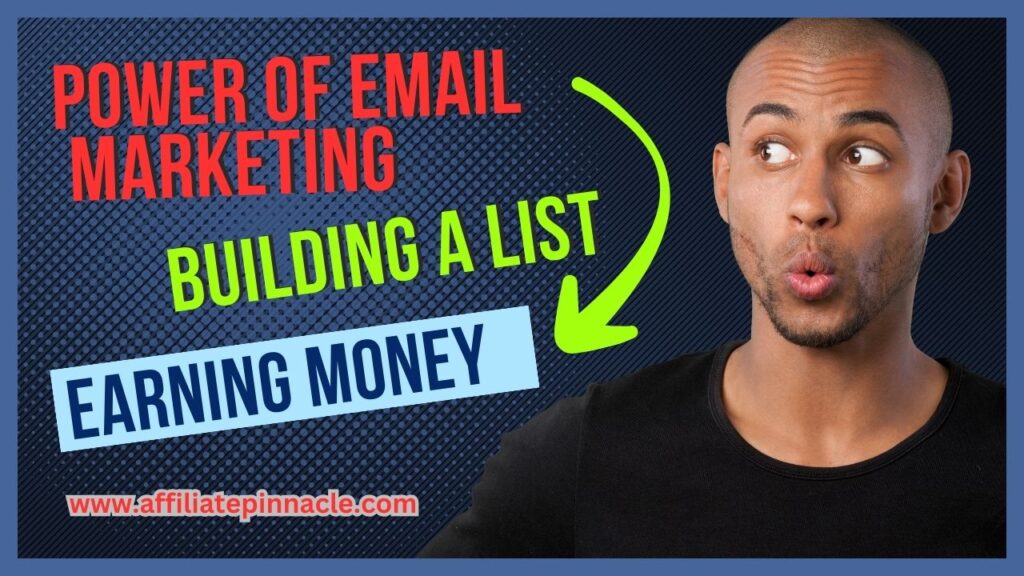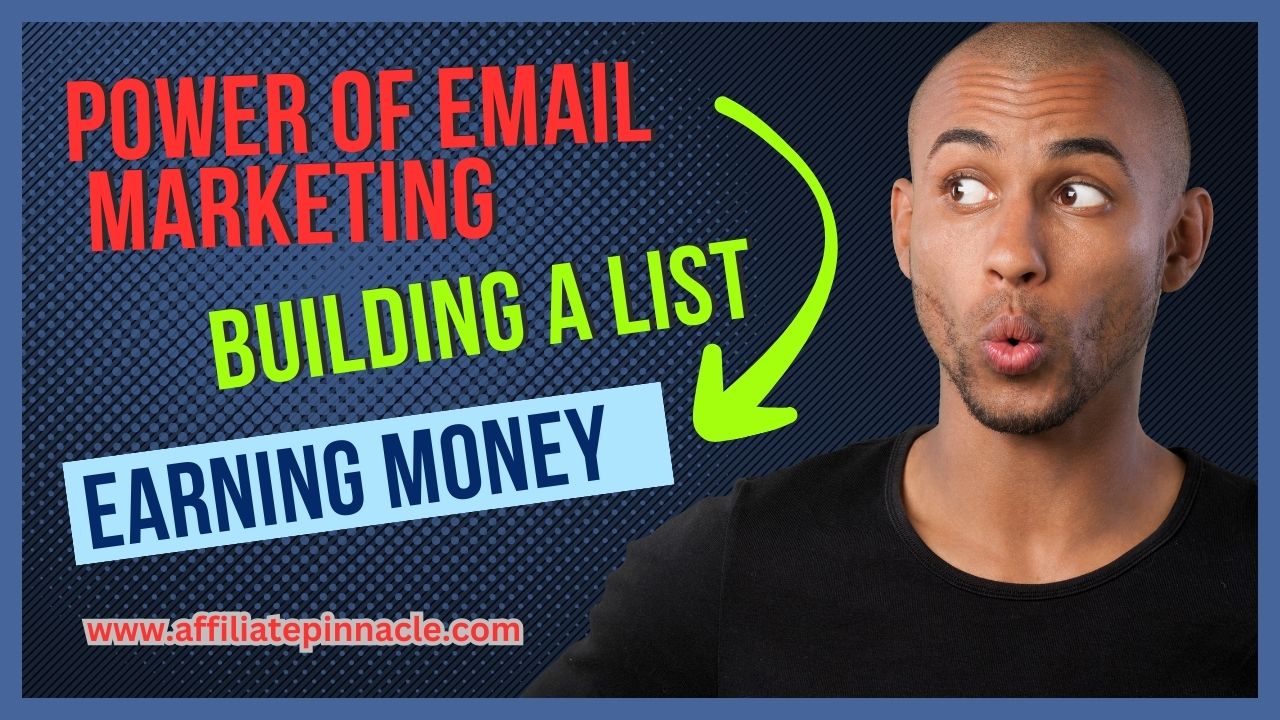In the ever-evolving world of digital marketing, one strategy has stood the test of time and continues to be a potent tool for businesses and entrepreneurs – email marketing. It’s not just about sending out newsletters; it’s a comprehensive approach that involves building a robust email list and leveraging it to earn money and grow your brand. In this article, we’ll explore the power of email marketing and provide five essential points to help you build a list and monetize it effectively.
- The Foundation: Building a Quality Email List
Building a quality email list is the cornerstone of successful email marketing. Here’s how to do it effectively:
Create Valuable Content: Offer high-quality content, such as ebooks, webinars, or exclusive insights, in exchange for email sign-ups. Make sure your content aligns with your audience’s interests.
“Cash Flow Explosion: Start Earning Big Bucks TODAY – Absolutely FREE Training!”

Use Opt-In Forms: Place opt-in forms strategically on your website, blog, and social media platforms. Make it easy for visitors to subscribe to your emails.
Segment Your List: Categorize subscribers based on their interests or behaviors. This allows you to send targeted, relevant content to different segments, increasing engagement and conversions.
Run Contests or Giveaways: Organize contests or giveaways with email sign-up as an entry requirement. This can quickly boost your list while generating excitement.
Leverage Social Media: Promote your email sign-up forms on your social media profiles to capture a broader audience.
- Nurture and Engage Your Subscribers
Once you have a list, your next step is to nurture and engage your subscribers:
Welcome Series: Create an automated welcome series that introduces new subscribers to your brand and provides them with valuable content.
Regular Updates: Send out regular emails with informative and engaging content, such as newsletters, blog updates, or product announcements.
Personalization: Use subscribers’ names and personalize your emails to make them feel valued and connected to your brand.
Interactive Content: Incorporate interactive elements like surveys, polls, or quizzes to encourage engagement and gather valuable feedback.
- Monetizing Your Email List
Now, let’s delve into how you can earn money from your email list:
Promote Affiliate Products: Share relevant affiliate products or services with your subscribers, earning a commission for each sale made through your unique affiliate links.
Sell Your Products or Services: Promote your own products or services directly to your email list, offering exclusive discounts or early access to incentivize purchases.
Advertise for Sponsors: If your email list is substantial and engaged, you can partner with sponsors or advertisers to promote their products or services to your subscribers for a fee.
Launch Webinars or Online Courses: Use your email list to market and sell webinars, online courses, or workshops, leveraging your expertise to generate income.
- A/B Testing and Optimization
Continuously improving your email marketing strategy is vital:
A/B Testing: Conduct A/B tests on different elements of your emails, such as subject lines, content, and CTAs, to determine what resonates best with your audience.
Optimize for Mobile: Ensure your emails are mobile-responsive to reach subscribers on various devices.
Analyze Metrics: Regularly review key metrics like open rates, click-through rates, and conversion rates to identify areas for improvement.
Email Timing: Experiment with the timing and frequency of your emails to find the optimal schedule for your audience.
- Compliance and Privacy
Lastly, ensure that your email marketing practices comply with regulations and respect subscribers’ privacy:
GDPR and CAN-SPAM: Familiarize yourself with data protection regulations like GDPR (for European subscribers) and CAN-SPAM (for U.S. subscribers) and adhere to their requirements.
Unsubscribe Option: Always include a clear and easy-to-find unsubscribe option in your emails to respect subscribers’ choices.
Data Security: Safeguard subscriber data and ensure it’s stored securely to protect against data breaches.
In conclusion, email marketing is a formidable tool for building and monetizing your audience. By focusing on building a quality email list, nurturing and engaging subscribers, monetizing strategically, continually optimizing your approach, and complying with privacy regulations, you can harness the power of email marketing to grow your brand and earn money effectively in the digital landscape.
The Foundation: Building a Quality Email List
Email marketing has retained its position as one of the most effective digital marketing strategies, delivering a high return on investment (ROI) for businesses and individuals alike. However, the success of your email marketing campaigns hinges on one critical factor: the quality of your email list. In this article, we will explore the foundational principles of building a quality email list and provide five essential points to help you do so effectively.
- Create Irresistible Lead Magnets
Lead magnets are valuable incentives that entice website visitors or social media followers to share their email addresses. These incentives can take various forms, such as ebooks, guides, templates, webinars, or exclusive discounts. To create an effective lead magnet:
- Address a Pain Point: Identify a problem or challenge that your target audience faces and create a lead magnet that provides a solution.
- Offer High-Value Content: Ensure that your lead magnet offers substantial value and is relevant to your audience’s interests and needs.
- Prominently Display Opt-In Forms: Make sure opt-in forms for receiving the lead magnet are displayed prominently on your website or landing page.
- Opt-In Forms Placement and Design
The placement and design of your opt-in forms play a crucial role in encouraging sign-ups:
- Strategic Placement: Position opt-in forms where they are highly visible, such as in the header, sidebar, or as pop-ups on your website.
- Clear Call-to-Action (CTA): Use clear and compelling CTAs on your forms, such as “Subscribe Now” or “Get Instant Access.”
- Simplicity: Keep your forms simple and request only essential information, such as the subscriber’s name and email address.
- Segmentation for Targeted Sign-Ups
Segmenting your email list enables you to send highly relevant content to specific groups within your audience:
- Define Segmentation Criteria: Determine criteria for segmenting your audience, such as demographics, behavior, or interests.
- Customized Opt-In Forms: Create opt-in forms tailored to each segment, offering content or incentives that specifically appeal to them.
- Personalized Messaging: Craft personalized emails that address the unique interests and needs of each segment.
- Social Media Promotion
Leverage your social media presence to grow your email list:
“Cash Flow Explosion: Start Earning Big Bucks TODAY – Absolutely FREE Training!”
- Teasers and Announcements: Tease your lead magnets on social media platforms and announce their availability.
- Social Media Ads: Run targeted ads on platforms like Facebook and Instagram, directing users to your opt-in forms.
- Collaborations: Collaborate with influencers or partners in your niche to promote your lead magnets and gain access to their audiences.
- Consistency and Value
Consistency and delivering value are key to retaining subscribers and growing your list:
- Regular Content Updates: Keep your website or blog regularly updated with valuable content to attract new visitors and subscribers.
- Email Frequency: Be consistent in sending emails, but avoid overwhelming your subscribers with excessive emails.
- Deliver Value: Ensure that each email provides value to your subscribers, whether through educational content, exclusive offers, or updates.
Building a quality email list is a gradual process that requires dedication and strategy. By creating irresistible lead magnets, optimizing the placement and design of your opt-in forms, implementing segmentation, leveraging social media promotion, and consistently delivering value, you can lay a strong foundation for a high-quality email list. This list, when nurtured and engaged effectively, will become a valuable asset for your email marketing campaigns and overall business success.
Nurture and Engage Your Subscribers
Building a substantial email list is just the beginning of your email marketing journey. To truly harness the potential of your list, you must nurture and engage your subscribers. By establishing meaningful connections and delivering valuable content, you can build trust, boost engagement, and ultimately drive conversions. In this article, we will explore five essential points to help you nurture and engage your email subscribers effectively.
- Create a Welcoming Welcome Series
A well-designed welcome series is your opportunity to make a great first impression on new subscribers:
- Timely Engagement: Send the first email in your welcome series immediately after a subscriber signs up to capitalize on their interest.
- Introduce Your Brand: Use the initial emails to introduce your brand, its values, and the benefits subscribers can expect.
- Provide Value: Offer valuable content, such as tips, guides, or exclusive resources, that align with your subscribers’ interests and reasons for subscribing.
- Set Expectations: Clearly communicate the type and frequency of emails subscribers can expect to receive.
- Regular, Consistent Content
Consistency is key in email marketing. To maintain engagement:
- Stick to a Schedule: Send emails at a consistent frequency, whether it’s weekly, bi-weekly, or monthly, so subscribers know when to expect your messages.
- Varied Content: Diversify your email content to keep subscribers engaged. Mix informational content, promotions, and updates to maintain interest.
- Responsive Design: Ensure that your emails are mobile-responsive, as many subscribers will read your emails on mobile devices.
- Personalization Matters
Personalization can significantly impact engagement:
- Use Subscriber’s Name: Address subscribers by their names to make emails feel more personalized.
- Segmentation: Implement segmentation based on subscriber behavior or preferences to send tailored content.
- Recommended Content: Offer personalized product recommendations or content based on previous interactions or purchase history.
- Encourage Interaction
Engage your subscribers by encouraging interaction and feedback:
- Ask Questions: Pose questions in your emails to encourage replies or comments, creating a sense of two-way communication.
- Surveys and Polls: Use surveys or polls to gather feedback on your content and products, demonstrating that you value their opinions.
- Social Media Integration: Promote social media engagement by sharing social buttons and inviting subscribers to connect on your social platforms.
- Exclusive Content and Offers
Reward your subscribers with exclusive content and offers:
- Subscriber-Only Content: Share exclusive blog posts, guides, or videos that are only accessible to your email subscribers.
- Limited-Time Offers: Provide subscribers with early access or special discounts on products or services to make them feel valued.
- Announce Giveaways: Notify subscribers about upcoming giveaways or contests, encouraging them to participate.
Conclusion:
Nurturing and engaging your email subscribers is a continuous process that requires attention, strategy, and creativity. By creating a welcoming welcome series, maintaining a consistent email schedule, personalizing your content, encouraging interaction, and offering exclusive content and offers, you can build strong relationships with your subscribers and maximize the potential of your email marketing efforts. Remember that an engaged email list is more likely to convert, making subscriber engagement a vital aspect of your overall digital marketing strategy.
Monetizing Your Email List
Your email list is a valuable asset that can serve as a powerful revenue-generating tool when leveraged effectively. While providing value to your subscribers should always be a priority, there are several strategic ways to monetize your email list without compromising the trust you’ve built with your audience. In this article, we will explore five essential points to help you monetize your email list successfully.
- Affiliate Marketing Campaigns
Affiliate marketing is a popular and lucrative method for monetizing your email list. Here’s how it works:
- Select Relevant Products or Services: Identify affiliate products or services that align with your niche and would be of interest to your subscribers.
- Create Valuable Content: Craft informative and persuasive content around the affiliate products, emphasizing their benefits and solving specific problems for your audience.
- Include Affiliate Links: Insert affiliate links within your emails, making sure they are clearly disclosed as such to maintain transparency.
- Measure Performance: Use tracking and analytics tools to monitor the performance of your affiliate campaigns. Track clicks, conversions, and commissions earned.
- Segment Your List: Consider segmenting your email list based on subscribers’ interests to send targeted affiliate offers that are more likely to resonate with specific segments.
- Promote Your Own Products or Services
If you have your products or services to offer, your email list is an ideal platform to promote them:
“Cash Flow Explosion: Start Earning Big Bucks TODAY – Absolutely FREE Training!”
- Product Launches: Notify your subscribers about new product launches, providing early access or exclusive discounts.
- Educational Content: Create informative content that highlights how your products or services can solve specific problems or enhance subscribers’ lives.
- Customer Testimonials: Share testimonials or case studies from satisfied customers to build trust and credibility.
- Limited-Time Offers: Encourage subscribers to take action by offering limited-time promotions or bonuses.
- Sponsored Emails and Partnerships
Collaborating with sponsors or partners can be a profitable way to monetize your email list:
- Identify Relevant Partners: Seek out sponsors or partners whose products or services align with your audience’s interests.
- Sponsored Emails: Send dedicated emails that promote the sponsor’s offerings, ensuring that the content is valuable and relevant to your subscribers.
- Affiliate Commissions: Negotiate affiliate commissions or flat fees with sponsors based on the performance of your sponsored emails.
- Webinars and Online Courses
Webinars and online courses can generate revenue while providing valuable educational content:
- Webinars: Host webinars on topics of interest to your audience, charging an entry fee or promoting products or services at the end.
- Online Courses: Develop and sell online courses that provide in-depth knowledge and skills related to your niche.
- Early Access for Subscribers: Offer subscribers exclusive access or discounted rates to incentivize their participation.
- Sell Ad Space
If your email list is substantial and engaged, you can sell ad space to third-party advertisers:
- Establish Rates: Determine competitive advertising rates based on your list’s size and engagement metrics.
- Select Relevant Advertisers: Partner with advertisers whose products or services are relevant to your audience.
- Clear Disclosure: Ensure that sponsored content or advertisements are clearly disclosed to your subscribers.
- Monitoring and Reporting: Regularly monitor the performance of ad campaigns and provide advertisers with detailed reports on click-through rates and engagement.
Conclusion:
Monetizing your email list can be a rewarding endeavor when executed thoughtfully and ethically. By incorporating affiliate marketing campaigns, promoting your products or services, exploring sponsored emails and partnerships, offering webinars and online courses, and selling ad space, you can transform your email list into a revenue-generating asset while maintaining the trust and engagement of your subscribers. Always prioritize providing value to your audience, as the success of your email marketing endeavors depends on the quality of the content and offers you deliver.
A/B Testing and Optimization
In the realm of email marketing, it’s not enough to send out emails and hope for the best. The key to improving your email marketing performance lies in A/B testing and optimization. By systematically testing different elements and optimizing your strategies, you can enhance engagement, increase conversions, and ultimately achieve better results. In this article, we will explore the significance of A/B testing and optimization in email marketing and provide five essential points to help you master these essential aspects of the trade.
“Cash Flow Explosion: Start Earning Big Bucks TODAY – Absolutely FREE Training!”
- Why A/B Testing Matters
A/B testing, also known as split testing, involves creating multiple versions of your email and sending them to different segments of your email list to determine which version performs better. Here’s why it matters:
- Data-Driven Decision Making: A/B testing provides empirical data that helps you make informed decisions about what works and what doesn’t in your email campaigns.
- Continuous Improvement: It allows you to iterate and refine your email content and strategies, improving their effectiveness over time.
- Increased Conversions: By identifying the most effective elements, you can optimize your emails to drive more conversions, whether that’s clicks, opens, or purchases.
- Elements to A/B Test
Several elements within an email can be subjected to A/B testing:
- Subject Lines: Test different subject lines to see which ones result in higher open rates. Experiment with length, tone, and personalization.
- Email Content: Test variations of your email’s body content, including different messaging, images, and layout.
- Call-to-Action (CTA): Experiment with different CTA buttons, text, colors, and placements to determine which ones drive more clicks.
- Sender Name: Test the impact of changing the sender’s name, whether it’s a personal name or a brand name.
- Timing: Experiment with different send times and days of the week to find the optimal schedule for your audience.
- Clear Hypotheses and Goals
Before conducting A/B tests, it’s essential to define clear hypotheses and goals:
- Hypotheses: Formulate hypotheses about what changes you believe will improve email performance. For example, “A shorter subject line will lead to higher open rates.”
- Goals: Determine specific goals for your A/B tests, such as increasing click-through rates by 10% or improving conversion rates for a particular product.
- Analyzing Results and Statistical Significance
Once you’ve conducted A/B tests, it’s crucial to analyze the results accurately:
- Statistical Significance: Ensure that your test results are statistically significant to draw valid conclusions. Use A/B testing tools that calculate statistical significance for you.
- Patience: Be patient when waiting for results, especially if you have a smaller email list. Rushing to conclusions based on limited data can lead to inaccurate decisions.
- Continuous Optimization
Optimization is an ongoing process in email marketing:
- Iterate and Test: After analyzing your A/B test results, make adjustments and test again to continually improve your email campaigns.
- Segmentation: Utilize segmentation to send more targeted and personalized emails to specific subscriber groups based on their behavior and preferences.
- Responsive Design: Ensure that your emails are mobile-responsive, as an increasing number of subscribers read emails on mobile devices.
- Data Analysis: Regularly review key email metrics like open rates, click-through rates, and conversion rates to identify areas for improvement.
Conclusion:
A/B testing and optimization are fundamental to the success of your email marketing campaigns. By systematically testing different elements, defining clear hypotheses and goals, analyzing results with statistical significance in mind, and practicing continuous optimization, you can refine your email strategies, enhance engagement, and drive better outcomes. Remember that email marketing is a dynamic field, and staying committed to testing and optimization will keep you at the forefront of success in this ever-evolving landscape.
Compliance and Privacy
In the digital age, privacy and data protection are paramount concerns for both consumers and businesses. When it comes to email marketing, adhering to compliance regulations and respecting subscriber privacy is not just good practice; it’s a legal and ethical imperative. In this article, we will explore the importance of compliance and privacy in email marketing and provide five essential points to help you navigate this critical aspect of your email marketing strategy.
- Understand GDPR and CAN-SPAM Regulations
Two of the most significant regulations governing email marketing are the General Data Protection Regulation (GDPR) and the Controlling the Assault of Non-Solicited Pornography And Marketing (CAN-SPAM) Act:
- GDPR: Applies to email marketing efforts targeting European subscribers. It requires clear consent for data collection, explicit opt-in procedures, and the right for subscribers to access, rectify, or erase their data.
- CAN-SPAM Act: Applies to email marketing in the United States. It mandates that emails must include clear identification of the sender, a functioning unsubscribe option, and valid postal addresses.
Understanding and complying with these regulations is essential to avoid legal repercussions and maintain trust with your subscribers.
- Consent-Based Marketing
One of the fundamental principles of privacy and compliance is obtaining explicit consent from subscribers:
- Opt-In Consent: Always use opt-in consent methods, where subscribers willingly provide their email addresses and agree to receive your emails.
- Double Opt-In: Consider implementing a double opt-in process, where subscribers confirm their subscription by clicking a verification link sent to their email address.
- Unsubscribe Options: Include an easy and clear method for subscribers to opt out of your emails, and respect their choices promptly.
- Data Security and Protection
Protecting the data you collect from subscribers is a non-negotiable aspect of compliance and privacy:
- Secure Storage: Safeguard subscriber data by storing it securely and using encryption where necessary to protect against data breaches.
- Data Access Control: Limit access to subscriber data within your organization to authorized personnel only.
- Data Retention Policies: Implement data retention policies that outline how long you will keep subscriber information and why.
- Honest and Transparent Practices
Honesty and transparency build trust with your subscribers:
- Disclosure: Clearly disclose why you are collecting subscriber data and how you plan to use it.
- Terms and Conditions: Include a link to your terms and conditions, privacy policy, and any relevant disclaimers in your emails.
- Email Content: Ensure that your email content accurately represents your offers or promotions. Avoid misleading or deceptive practices.
- Regular Compliance Audits
Regularly reviewing and updating your email marketing practices is vital:
- Audit Consent Records: Periodically review and audit your consent records to ensure that subscribers have opted in to receive your emails.
- Stay Informed: Stay up-to-date with changes in privacy regulations and compliance standards in your region and industry.
- Employee Training: Train your team members involved in email marketing on compliance and privacy best practices to ensure a consistent approach.
Conclusion:
Compliance and privacy are not optional in email marketing; they are foundational to ethical and legal email marketing practices. By understanding GDPR and CAN-SPAM regulations, obtaining consent, prioritizing data security, practicing honesty and transparency, and conducting regular compliance audits, you can safeguard your email marketing efforts and build trust with your subscribers. Maintaining a commitment to privacy and compliance not only ensures legal compliance but also strengthens your reputation as a responsible and trustworthy email marketer.
I appreciate you reading my full article,The Power of Email Marketing: Building a List and Earning Money



